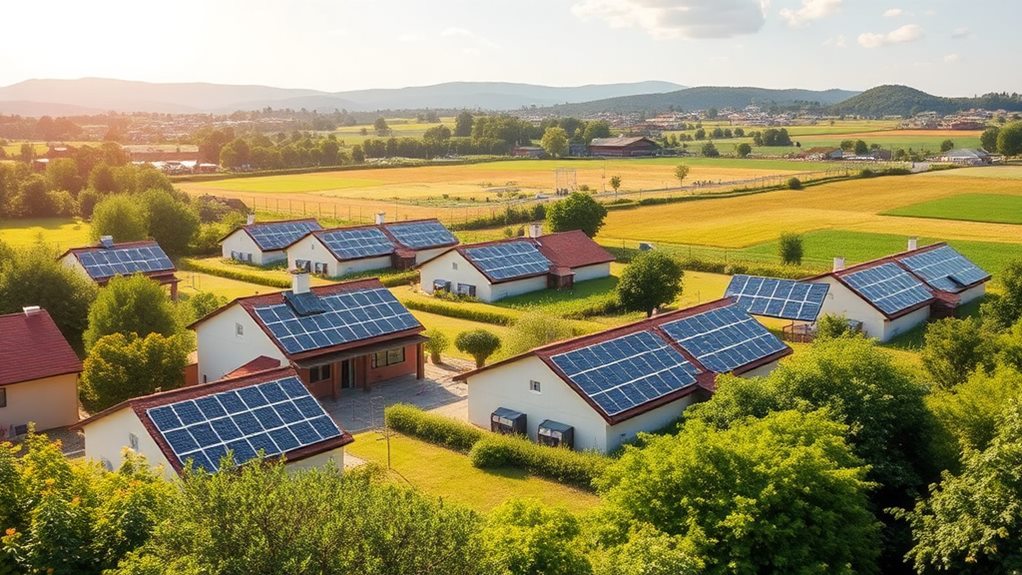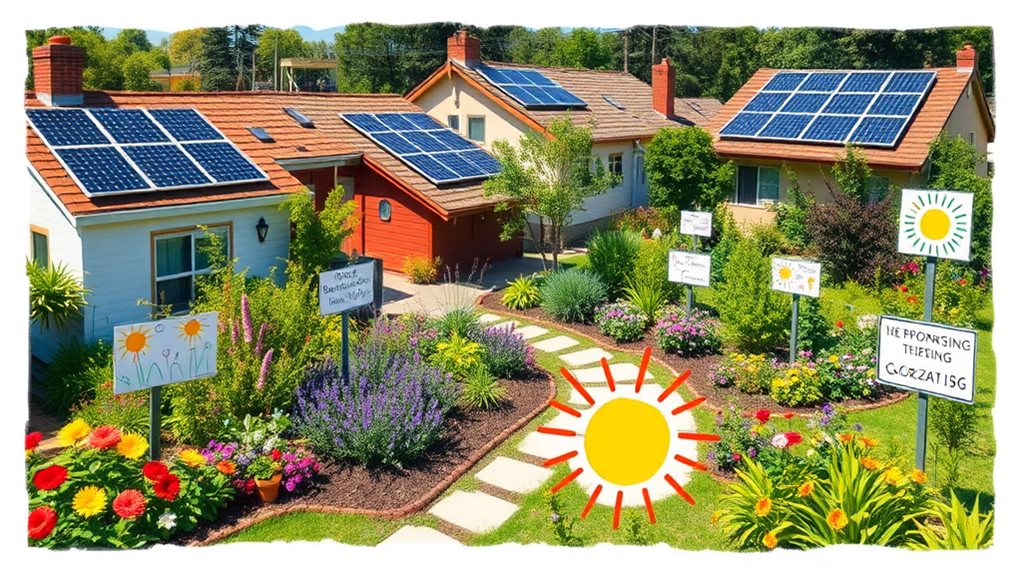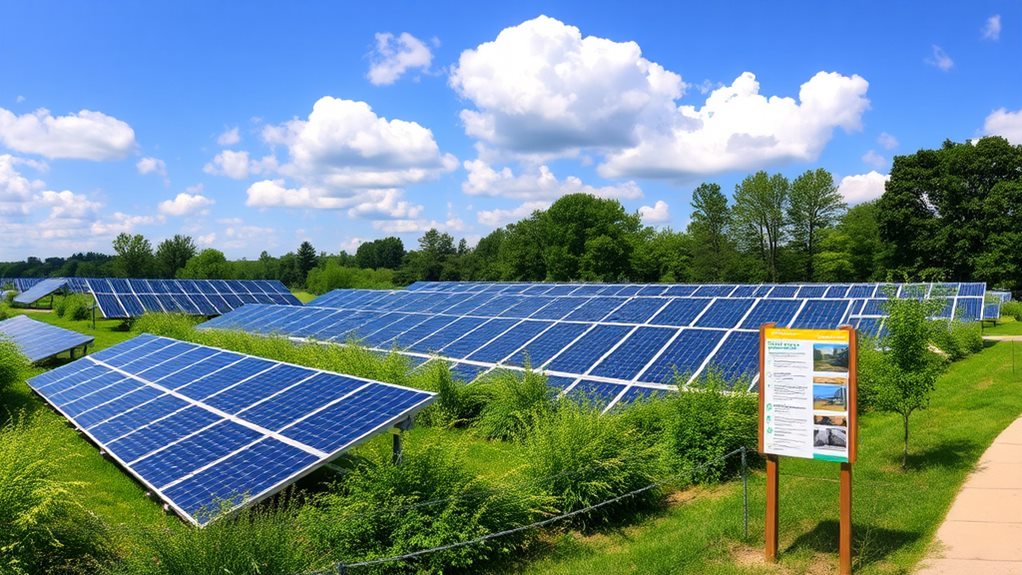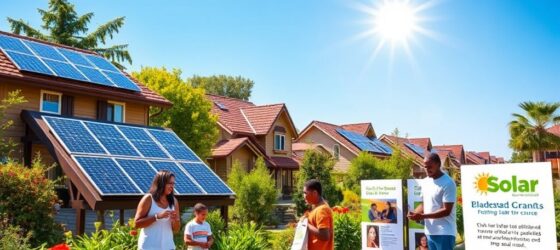To access local solar energy grants and programs, you should first identify available funding opportunities, such as the USDA's New ERA program and the $7 billion Solar for All initiative, aimed at providing solar access for low-income households. These grants can cover significant energy costs and support community projects. You'll need to prepare thorough project proposals that emphasize energy savings and community impact. Additionally, collaborating with local governments can strengthen your applications. Understanding the barriers to access, including upfront costs, will help you craft your approach. Explore these options further to effectively maximize the potential benefits for your community.
Overview of Local Solar Grants

Understanding local solar grants can open doors to notable energy savings for your agency or nonprofit. These grants, often provided by local governments and federal programs, can cover up to 100% of energy costs, helping you transform operational expenses.
For instance, the USDA's New ERA program allocates nearly $9.7 billion for renewable energy systems, including solar projects, specifically targeting local agencies and organizations like yours. In addition, many states offer solar energy tax credits that can markedly lower installation costs for solar panel systems.
Additionally, the Solar for All initiative, with its $7 billion budget, aims to enhance solar access for low-income households. Grants from the EPA, totaling approximately $1 billion, support regional solar projects that foster community solar programs. This approach allows local residents to participate in clean energy initiatives, even if they can't install solar panels on their properties.
With states under a 5-year deadline to deploy funds from various initiatives, it's vital for local governments and nonprofits to engage effectively to maximize the impact of solar funding.
Types of Solar Energy Programs
A variety of solar energy programs exist to cater to different needs and circumstances, making clean energy accessible to more communities. For instance, the Solar for All initiative focuses on low-income households, providing funding through grants from the EPA to help achieve at least 20% savings on energy bills.
These programs not only help reduce energy costs but also promote the adoption of long-term investment in solar energy by making it financially feasible for more families. Community solar programs also enhance accessibility by allowing multiple households to benefit from a single solar installation, expanding participation in clean energy projects.
Federal tax credits, such as the Investment Tax Credit, play an essential role in reducing the upfront costs of solar installations for both homeowners and businesses. These incentives can greatly lower the financial barrier associated with adopting solar energy.
Additionally, programs like the USDA's New ERA initiative provide approximately $9.7 billion specifically for renewable energy systems, including solar projects, promoting wider adoption across various sectors.
State-level initiatives further support these efforts. For example, Georgia and South Carolina have received substantial grants aimed at enhancing solar access and energy efficiency for low-income communities.
Together, these programs create a robust framework for fostering sustainable energy solutions and empowering individuals to shift to renewable energy sources.
Benefits for Communities and Nonprofits

How can communities and nonprofits harness the power of solar energy to drive positive change? By engaging in clean energy projects, you can tap into federal funding opportunities designed specifically for your needs. Programs like the $7 billion Solar for All initiative provide considerable financial assistance, enabling participating communities to save at least 20% on energy bills.
These savings can be redirected toward essential services, enhancing your operational efficiency and bolstering community development programs. Additionally, switching to solar power not only reduces utility bills considerably but also contributes to a cleaner environment by reducing reliance on fossil fuels, which supports sustainability and helps lower carbon emissions (financial savings).
Nonprofit organizations, in particular, stand to benefit greatly. Grants covering up to 100% of energy costs allow you to reallocate funds towards crucial initiatives that support vulnerable communities.
For example, Habitat for Humanity of Greater Sacramento effectively reduced its energy expenses through solar implementation, enhancing its public image while simultaneously improving operational capabilities.
Additionally, investing in solar programs not only leads to energy savings but also fosters local job creation in installation and maintenance sectors. This contributes to economic growth and builds resilience within your community.
Application Process for Grants
Steering through the application process for solar energy grants can seem intimidating, but it's manageable with the right approach. First, identify available funding opportunities, such as the $11 billion in clean energy grants from President Biden's administration. Understanding these avenues is essential for eligible entities, including municipalities, nonprofits, and federal facilities.
Additionally, California's commitment to achieving 100% clean energy by 2045 provides a robust backdrop for seeking solar funding, as various state incentives and rebates may further enhance your project's viability California welcoming the solar revolution.
Next, you'll need to prepare detailed project proposals. Highlight energy savings, operational benefits, and the community impact your project will have. These elements are vital for securing funding. Many grant programs also require evidence of cost-effectiveness, which you can demonstrate through energy audits and projections of long-term financial savings from your solar installation.
Don't forget to pay attention to grant deadlines. Funding agencies have specific timelines—like the 5-year deadline for the Solar for All initiative—that you must adhere to.
Collaborating with local governments and community organizations can further strengthen your application by showcasing community engagement and support for your solar project. This collaboration can greatly increase your chances of funding approval, so be proactive in building these relationships.
With diligence and preparation, you can successfully navigate the application process and secure the funding you need.
Addressing Barriers to Access

Accessing solar energy can be challenging, particularly due to high upfront costs that often put rooftop installations out of reach for low-income households.
To overcome these barriers, regulatory support is vital in creating equitable opportunities for solar adoption, while public awareness campaigns can help dispel misconceptions and clarify options like community solar projects.
High Upfront Costs
High upfront costs for solar installations create significant barriers to access, particularly for low-income households. Many low-income homeowners struggle to muster the capital needed for a solar installation, making it nearly impossible to benefit from clean energy solutions. Without adequate financing options, these households remain locked out of the solar market.
- The dream of energy independence feels out of reach.
- Monthly utility bills continue to strain budgets.
- Environmental justice seems like a distant goal.
- Families miss out on potential savings and sustainable energy.
Community solar programs, while beneficial, often come with premium pricing, further complicating access. In Tennessee, where the average monthly energy bill exceeds $130, the burden of high upfront costs can be overwhelming.
State and local governments play an essential role in developing policies that ease these financial barriers. Initiatives like technical assistance and targeted financing solar options can help bridge the gap. By addressing high upfront costs, you can make solar energy more accessible and equitable for everyone, ensuring that all homeowners, regardless of income, can take advantage of the benefits of solar energy.
Regulatory Support Needed
Regulatory support is essential for breaking down the barriers that prevent low-income households from adopting solar energy solutions. High installation costs and punitive utility policies, like excessive monthly fees, can deter you from pursuing solar projects.
Without adequate regulatory frameworks, tax credits and incentives often fail to reach those who need them most, leaving many low-income families unable to afford solar installation.
In states like Tennessee, where average energy bills exceed $130 per month, inadequate compensation for electricity you export back to the grid further discourages rooftop solar adoption.
By enhancing regulatory support, states can create equitable access to solar incentives that directly benefit underserved communities. This support includes simplifying the process for hiring a solar installer and ensuring that community solar programs are accessible to all.
Additionally, addressing public misconceptions about solar energy can empower you to make informed decisions.
When regulatory frameworks prioritize equity in renewable energy solutions, they pave the way for lower energy bills and a sustainable future.
Public Awareness Campaigns
To effectively bridge the gap in solar energy access, public awareness campaigns are essential. These initiatives play a critical role in educating low-income households about the $7 billion Solar for All initiative, which aims to enhance solar access and deliver significant energy bill savings.
Many community solar projects are often perceived as exclusive, leading to misconceptions that solar energy is only for affluent households. To dismantle these barriers, outreach initiatives must target underserved communities.
Consider these impacts:
- Empowering families to save on energy bills
- Connecting communities with affordable solar options
- Bridging language and technological gaps
- Fostering local engagement through trusted organizations
Simplifying application processes and increasing funding for outreach can encourage participation. It's crucial to implement multilingual resources and tailored educational materials, guaranteeing that everyone can understand their options.
Engaging local organizations and trusted intermediaries in these public awareness campaigns will promote greater community involvement. By focusing on these strategies, we can guarantee equitable access to clean energy technologies for all residents, paving the way for a sustainable future and empowering those who need it most.
Future of Solar Incentives and Funding
As you consider the future of solar incentives and funding, you'll notice a shift towards evolving grant opportunities that prioritize community engagement.
These changes not only enhance access to solar technology but also empower local stakeholders to take part in decision-making processes.
Evolving Grant Opportunities
The landscape of solar energy funding is rapidly changing, presenting exciting new grant opportunities for those enthusiastic to invest in clean energy. With over $11 billion available for clean energy projects, including solar initiatives, the potential for innovation is immense. The USDA's New ERA program alone is providing nearly $9.7 billion specifically for renewable energy systems, fostering a competitive environment for solar projects.
Consider these compelling reasons to get involved:
- Empower your community by reducing dependence on fossil fuels.
- Unlock significant funding through various incentive programs.
- Transform your energy future with state-of-the-art solar panels.
- Provide lower energy costs for vulnerable households.
Furthermore, agencies and nonprofits can secure up to $100 million in forgivable loans, emphasizing the urgency to act quickly.
The $7 billion Solar for All initiative aims to enhance solar access for low-income families, with nearly $1 billion in EPA grants earmarked for vulnerable communities.
With a five-year deadline on deploying these funds, it's essential to engage with state leaders to maximize the impact of your investment in local solar projects.
The future of solar power is bright, and now's the time to seize these evolving grant opportunities.
Community Engagement Strategies
Many communities are missing out on fundamental solar energy grants and programs due to a lack of awareness and engagement. To bridge this gap, effective community engagement strategies are important. Targeted outreach initiatives can greatly increase awareness of available solar grants, especially in underserved areas where access to information is limited.
Collaborating with trusted local organizations can facilitate the dissemination of essential information, guaranteeing that community members are informed about these opportunities.
Incorporating multilingual resources and culturally relevant materials will enhance participation among diverse populations, addressing language barriers and fostering inclusivity in solar energy initiatives. Community-driven renewable energy projects, like those supported by the 30 Million Solar Homes Coalition, exemplify the power of grassroots engagement in promoting equitable access to clean energy incentives.
To refine outreach efforts, it's important to monitor and evaluate the effectiveness of these community engagement strategies. This ongoing assessment will help guarantee that solar funding opportunities reach those who need them most, ultimately leading to a more sustainable and inclusive approach to renewable energy.
Final Thoughts
Unleashing local solar energy grants and programs is like opening a door to a brighter future, where communities can thrive sustainably. By accessing these resources, you not only empower your neighborhood but also contribute to a cleaner environment. The benefits extend beyond immediate financial support, fostering collaboration among nonprofits and residents. As solar incentives evolve, staying informed and engaged will guarantee that you can maximize these opportunities, ultimately paving the way for a more resilient and eco-friendly community.


Recent Comments